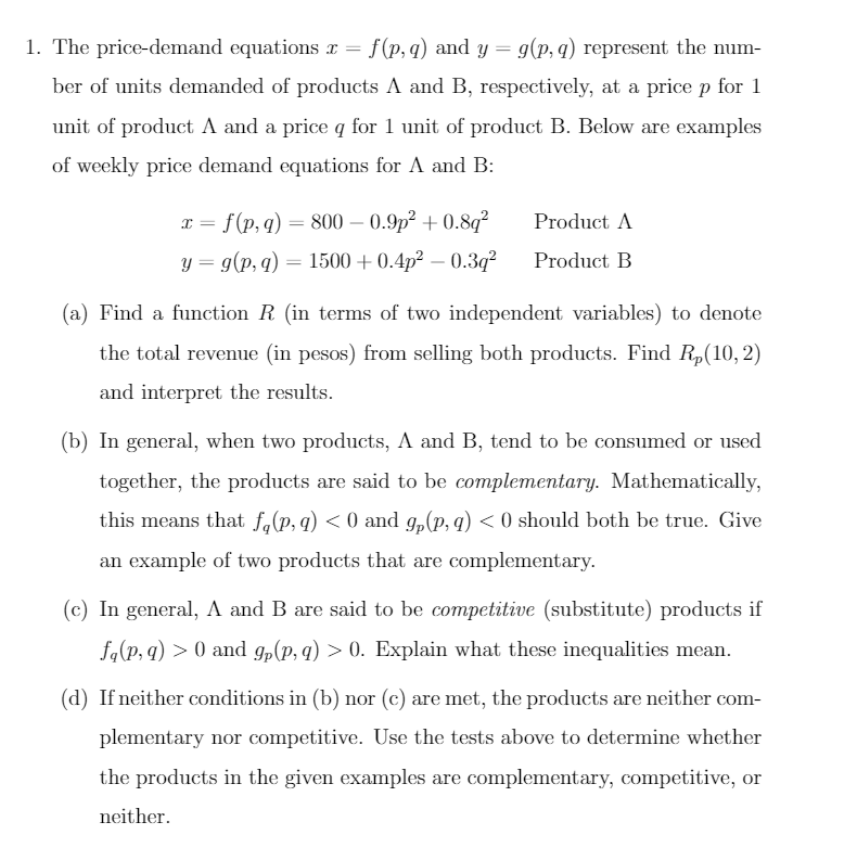The price-demand equations x = f(p, q) and y = g(p, q) represent the num- ber of units demanded of products A and B, respectively, at a price p for 1 init of product A and a price q for 1 unit of product B. Below are examples of weekly price demand equations for A and B: T = f(p,g) = 800 – 0.9p² +0.89² Product A
The price-demand equations x = f(p, q) and y = g(p, q) represent the num- ber of units demanded of products A and B, respectively, at a price p for 1 init of product A and a price q for 1 unit of product B. Below are examples of weekly price demand equations for A and B: T = f(p,g) = 800 – 0.9p² +0.89² Product A
Advanced Engineering Mathematics
10th Edition
ISBN:9780470458365
Author:Erwin Kreyszig
Publisher:Erwin Kreyszig
Chapter2: Second-order Linear Odes
Section: Chapter Questions
Problem 1RQ
Related questions
Question
CAN YOU WRITE DOWN BREIF SOLUTIONS PLEASE

Transcribed Image Text:1. The price-demand equations r = f(p, q) and y = g(p, q) represent the num-
ber of units demanded of products A and B, respectively, at a price p for 1
unit of product A and a price q for 1 unit of product B. Below are examples
of weekly price demand equations for A and B:
I = f(p, q) = 800 – 0.9p² + 0.8q²
Product A
y = g(p, q) = 1500 + 0.4p² – 0.3q?
Product B
(a) Find a function R (in terms of two independent variables) to denote
the total revenue (in pesos) from selling both products. Find R„(10,2)
and interpret the results.
(b) In general, when two products, A and B, tend to be consumed or used
together, the products are said to be complementary. Mathematically,
this means that f,(p, q) < 0 and g,(p, q) < 0 should both be true. Give
an example of two products that are complementary.
(c) In general, A and B are said to be competitive (substitute) products if
fa(p, q) > 0 and g„(p, q) > 0. Explain what these inequalities mean.
(d) If neither conditions in (b) nor (c) are met, the products are neither com-
plementary nor competitive. Use the tests above to determine whether
the products in the given examples are complementary, competitive, or
neither.
Expert Solution
This question has been solved!
Explore an expertly crafted, step-by-step solution for a thorough understanding of key concepts.
Step by step
Solved in 3 steps with 7 images

Knowledge Booster
Learn more about
Need a deep-dive on the concept behind this application? Look no further. Learn more about this topic, advanced-math and related others by exploring similar questions and additional content below.Recommended textbooks for you

Advanced Engineering Mathematics
Advanced Math
ISBN:
9780470458365
Author:
Erwin Kreyszig
Publisher:
Wiley, John & Sons, Incorporated

Numerical Methods for Engineers
Advanced Math
ISBN:
9780073397924
Author:
Steven C. Chapra Dr., Raymond P. Canale
Publisher:
McGraw-Hill Education

Introductory Mathematics for Engineering Applicat…
Advanced Math
ISBN:
9781118141809
Author:
Nathan Klingbeil
Publisher:
WILEY

Advanced Engineering Mathematics
Advanced Math
ISBN:
9780470458365
Author:
Erwin Kreyszig
Publisher:
Wiley, John & Sons, Incorporated

Numerical Methods for Engineers
Advanced Math
ISBN:
9780073397924
Author:
Steven C. Chapra Dr., Raymond P. Canale
Publisher:
McGraw-Hill Education

Introductory Mathematics for Engineering Applicat…
Advanced Math
ISBN:
9781118141809
Author:
Nathan Klingbeil
Publisher:
WILEY

Mathematics For Machine Technology
Advanced Math
ISBN:
9781337798310
Author:
Peterson, John.
Publisher:
Cengage Learning,

